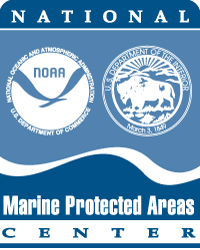The MPA Inventory

NOAA's Marine Protected Areas Inventory (MPA Inventory) describes all MPAs in US waters, where they are and what they do. This comprehensive geospatial database combines publicly available data with information from state and federal MPA programs. It can be used to view MPAs, explore status and trends of MPAs, create customized maps and analytical products, or add MPAs to data portals, online viewers and other spatial data visualizations.
As of the 2020 version, the MPA Inventory provides boundary and classification information exclusively for MPAs that meet the international protected area definition established by the International Union for Conservation of Nature (IUCN). IUCN protected areas are defined as:
A clearly defined geographical space, recognised, dedicated, and managed, through legal or other effective means, to achieve the long-term conservation of nature with associated ecosystem services and cultural values.
Boundaries and attribute data for managed areas that do not meet these criteria (e.g., fishery management areas, water quality areas, and recreational use restricted areas) are accessible through the Protected Seas database, built in partnership with Anthropocene Institute.
MPA Inventory Data (Updated 2023)
The MPA Inventory is published in various formats to meet a wide range of user needs:
- Online interactive map
- Downloadable GIS data
- Excel Spreadsheet
- Web Mapping Services (hosted feature service)
- Metadata
Classification System
To clarify discussion about various MPA issues, the National Marine Protected Areas Center developed a MPA classification system to simplify the often confusing diversity of MPA terminology. The classification system is intended to provide an objective and intuitive way to understand, describe, and constructively assess most MPAs found in the United States.
Analyzing the Inventory
The MPA Inventory is the primary source for MPA data used for reporting on global targets and communicating coverage of U.S. MPAs. Analysis of the Inventory can support a wide range of research and policy interests, as illustrated in the following:
- Marine Protected Areas 2020: Building Effective Conservation Networks (view as a report)
- Conserving our Oceans One Place at a Time: A detailed exploration of the MPA Inventory (2017) as a tool for evaluating MPA status and trends.
- MPA Representativeness Report: An assessment of MPA distribution in relation to critical habitats and ecologically important areas.
Related Resources
Marine Managed Areas in U.S. waters: In partnership with the MPA Center, the Anthropocene Institute has developed the Protected Seas database that offers spatial boundary data along with summarized regulations information for over 3000 managed areas in U.S. waters. Available as downloadable GIS and as a web mapping service, this database is intended to inform mariners and other ocean users about place-based regulations related to extraction of living marine resources.
De Facto MPAs: In 2008, the MPA Center published a DeFacto MPA database of areas officially delineated for reasons other than conservation, such as economic use, human health or safety, protection of government or private property, or national security. See the De Facto MPAs inventory.
MPA Inventory Updates
The MPA Inventory is updated annually. Please contact us with any new site information, existing site clarifications or updated spatial boundary data.
Disclaimer
The MPA Inventory is not designed for regulatory purposes. For official boundary definitions and regulations, please consult the Code of Federal Regulations or relevant state code.
 Marine Protected Areas
Marine Protected Areas